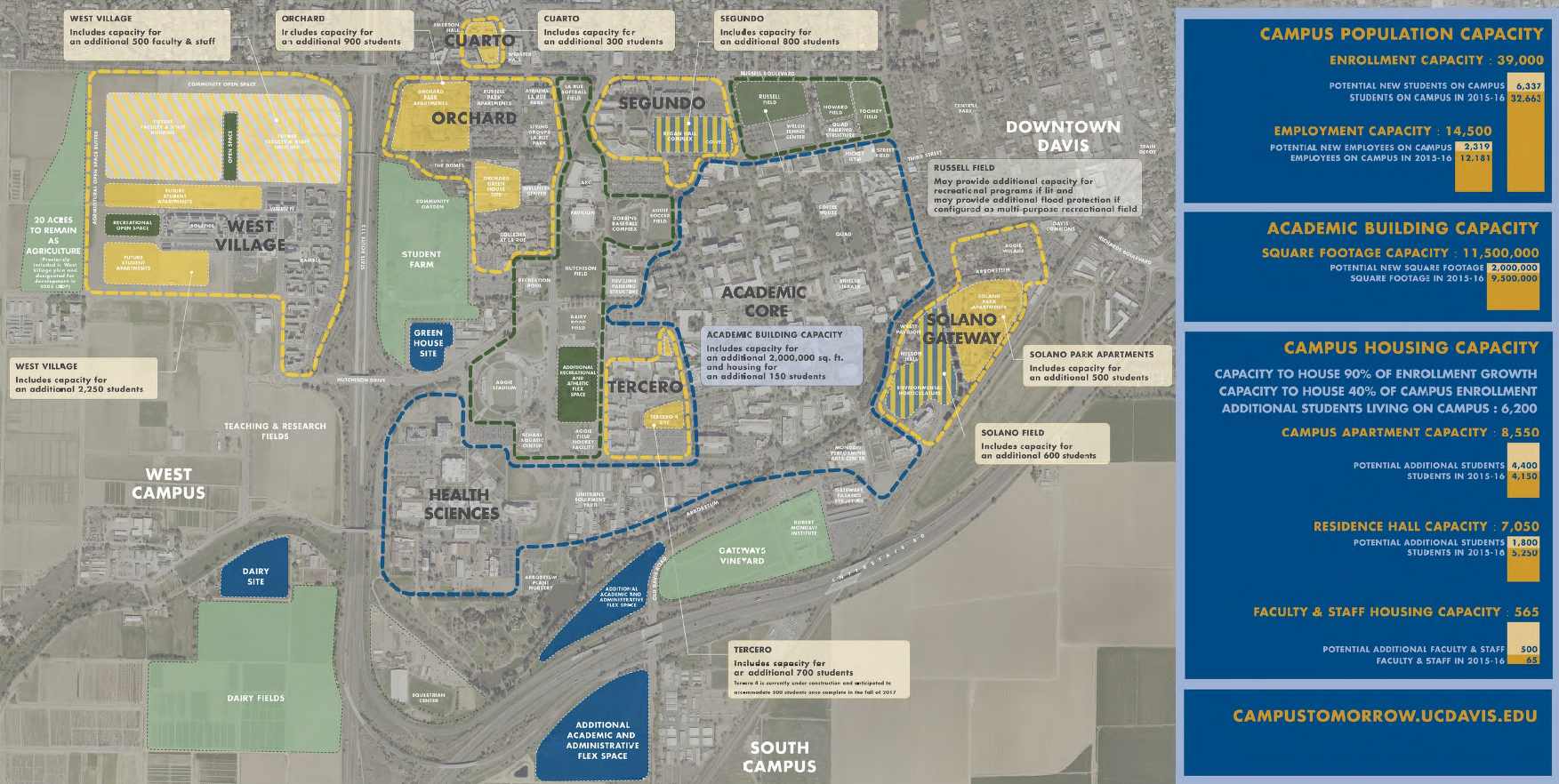
At the December 6 Davis City Council meeting, UC Davis Vice Chancellor for Campus Planning & Community Bob Segar made a public presentation in which the university acceded to the wishes of the city and community by removing housing proposals from the Russell Fields, but went forward with its stated goal of providing housing for only 90 percent of new students and 40 percent overall.
The city council sent a letter to Acting Chancellor Ralph Hexter on the Long Range Development Plan (LRDP), requesting “that UC Davis incorporate into the LRDP substantial additional on-campus housing units and housing density, and provide clear definition of non-residential space increase needs and how those increases will be accommodated on-campus.”
Specifically, the council requested that “UC Davis provide for a minimum of 100 percent of the projected enrollment of all new incoming students starting with the 2017 academic year and at least 50 percent of total UC Davis campus student population in the LRDP.”
However, UC Davis has stuck with their timeline and proceeded to issue a Notice of Preparation (NOP), moving forward with the environmental review phase.
In a draft letter to Ralph Hexter, Mayor Robb Davis writes, “The City of Davis is in receipt of the Notice of Preparation (NOP) of an Environmental Impact Report (EIR) for the UC Davis 2017 Long Range Development Plan. Attached, please find the comments submitted by the City of Davis regarding the scope and content of the EIR, including reasonable alternatives and mitigation measures, that the City of Davis believes will be necessary to ascertain the potential environmental impacts of the LRDP.
“We are appreciative of the previous and ongoing engagement of campus staff with our community, our City staff, and our City Council LRDP subcommittee and thank you for your prompt and serious consideration of these matters. We remain committed to engaging in dialogue with UC Davis as you consider your responses to these comments.”
In the draft letter from Harriet Steiner, Davis City Attorney, to Matt Dulcich, Assistant Director of Environmental Planning, she writes, “The City is appreciative of the previous and ongoing engagement of campus staff with the community.” She adds that “there are many questions regarding the proposed development of the campus under the LRDP that are unanswered or information that is unclear or incomplete that must be clearly defined before there will be an adequate Project Description to evaluate in the EIR.”
Based on this, she asks “that UC Davis issue a revised and updated NOP, with a new scoping period.”
Ms. Steiner highlights four points.
First, “It is unclear from the Project Description of the LRDP provided in the NOP how the LRDP will fully meet the Project Goals and Objectives to Support the Academic Enterprise through the development of Academic and Administrative space.”
Here she argues that the NOP provides only general data on acreage for such space and “no breakdown of how many square feet of each academic/office/R&D/support space will be needed to accommodate the projected growth, whether the proposed amount of such space will be (or is considered to be) sufficient to accommodate the Project growth in full, and whether the proposed space will allow UC Davis to re-absorb onto campus such space that is currently occupied within the City of Davis and other nearby communities.”
Second, she reasons, “The NOP should explain the rationale, in a manner that reflects the LRDP’s Project Objectives, for UC Davis’ proposal to house no more than 40% of enrollment on campus, as well as its assumptions and rationale for the percentage of students living off campus and outside of Davis. This is necessary to inform public understanding of the Project, potential impacts, and feasible mitigation measures to reduce potential impacts.”
Third, “The NOP should provide a list of the intersections and roadway segments proposed to be evaluated in the EIR.”
Fourth, there needs to be clarification regarding population estimates.
She writes that “the NOP states that LRDP has until now used enrollment data for the 2014-15 academic year, but updated 2015-16 data will be used as the base year for the EIR. Accordingly, it is unclear precisely what enrollment data will form the basis for the Project scope and description, making informed comment on the scope challenging.”
Ms. Steiner further notes that, while the expanded student population is a 6337 increase, there are also increases to employment by 2319 – for a combined total of 8656 additional people on campus. But that does not include: “the combined total of 2,364 additional community college students (615), dependents of UC residents (1,444) and non-UCD employees (305), which when added to student and employment growth will result in a total net increase of 11,020.”
Harriet Steiner writes, “The NOP should reflect that these additional direct and indirect ‘maximum’ population increases so that they will be accounted for and analyzed in the EIR.”
She further notes, “The NOP states that the LRDP assumes 40% (15,600) students will live on campus by 2027-28, but does not describe how the remaining 60% (23,400) will be allocated between the City of Davis and other communities and the rationale for that allocation.”
Finally she notes, “The on-campus population of student and staff exceeded the projections in the 2003 LRDP. To form a sound understanding of the baseline existing conditions, the NOP should reflect that the EIR will articulate how much these projections were exceeded, an understanding of why this occurred, why it may or may not occur again in the future with regard to the 2017 LRDP projections, and what the environmental impacts of such exceedances would be.”
The LRDP 40 percent housing goal, she writes, “represents an aspirational ‘ceiling’ of on-campus development for housing units. Based on the attached documentation, UC Davis has historically not met prior on-campus housing goals associated with former LRDP’s and MOU’s with the City.”
In her view, “The EIR should disclose and analyze anticipated impacts if anything less than the proposed housing ‘ceiling’ is not constructed, particularly with respect to local and regional housing, greenhouse gas, air quality, and traffic/circulation impacts.”
The letter, with respect to housing, notes, “The City of Davis is concerned that the Project, as detailed in the NOP, will not fully meet the UC Davis’s Project Goals and Objectives to enrich community life with residence halls and student apartments and to promote affordable and accessible residential communities.
“The LRDP proposes to provide housing for only 90 percent of new enrollment and 40 percent of total campus enrollment, neither of which, as acknowledged in the NOP, is sufficient to meet the Projected growth of the university.”
The city therefore believes that the housing proposal will result “in a number of direct and indirect significant impacts on the environment.” Each of these “will need to be feasibly mitigated.”
The city therefore requests an equal weight alternative evaluating the impact of providing for 100 percent of the new housing. “Housing at least 50% of the student population on campus is a common and reasonable housing approach that has already been embraced by multiple UC campuses, including UC Irvine, UC Merced, UC San Diego, UC Santa Barbara, UC Santa Cruz, and UC Riverside.”
She writes, “We are aware that UC Davis has recently issued statements suggesting that they will be considering more housing on campus as the LRDP ‘process unfolds,’ but we would be concerned that such an approach would result in an unstable Project Description, in violation of CEQA. Including a 50/100 plan in the EIR as an equal weight alternative would more fully inform the UC Regents as they consider LRDP adoption, is in the best interests of full disclosure, and will afford all parties a better understanding of the implications of various housing alternatives.”
—David M. Greenwald reporting






Thank You to Ms. Steiner and the City Council for sending this letter! I am glad that they are pressing this issue, 50% of students being housed on campus is a good goal and I really hope that the University will eventually attain it.
I recently got a job at the University and moved to this town. I absolutely love living in Davis and dream of staying here long term. But, like the majority of UC Davis Staff, I do not see a financially feasible way to do that with the lack of affordable family housing.
I hope that the University takes action. Not just for its students, but also for its employees. The faculty and staff housing proposed in the LRDP is far too expensive and far too small.